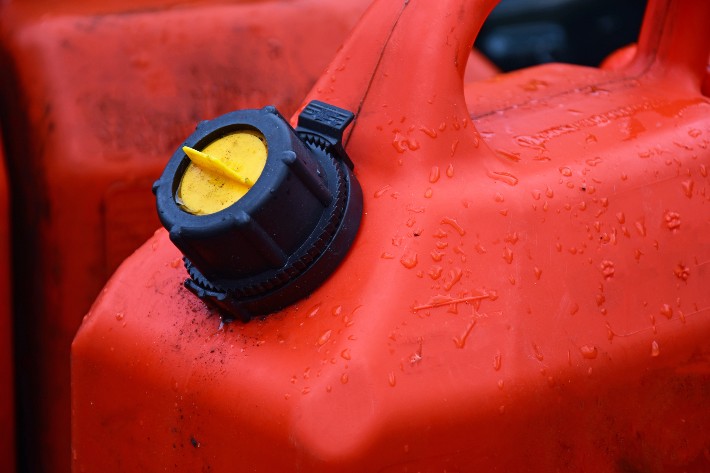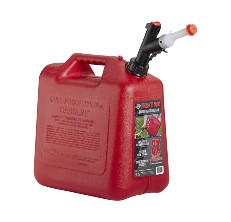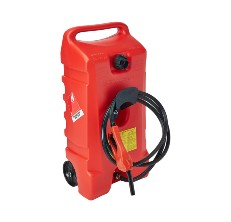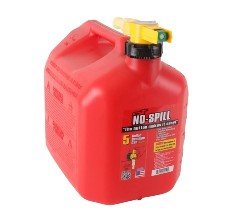- Flowers & PlantsVegetables
The Best Gas Cans of 2024
Last updated: Apr 4, 2024
Whether you’re powering up your lawn mower or relying on a generator during a power outage, a gas can ensures you always have the fuel you need on hand. With added safety features and durable constructions, these metal or plastic canisters offer a reliable way to store an extra supply of gasoline. In this post, we’ll review the best gas cans of 2024 and show you all you need to know before choosing the right one for your needs. Our top pick is the Press 'N Pour gas can from Garage Boss due to its innovative safety features and the clean experience it provides.
Our Top Picks For Gas Cans
- Best Overall: Garage Boss Gas Can Shop Now ➔
- Runner Up: Scepter USA Gas Can Shop Now ➔
- Contender: No-Spill Gas Can Shop Now ➔
View all ContentsThe Best Gas Cans
Best Overall
If you want a safe and reliable gas can, the Press ‘N Pour from Garage Boss is a great option. Its simple press button gives you complete control over when the fuel begins to flow and how fast it flows. You’ll also enjoy the excellent precision and guaranteed no mess or spill that this can offers.
It features a child-safe cap that prevents fumes, leakage, and unnecessary spills, ensuring a clean experience with every use. With its flame-mitigation technology, EPA and CARB compliance, and convenient flow rate control, this gas can earned the top spot on our list.
Pros
- Child-safe cap prevents mess
- Ability to adjust the fuel flow rate
- EPA, CARB-compliant design
Cons
- Safety feature can take getting used to
Runner Up
The Flo-N-Go, a fuel caddy from Scepter USA, is the largest available gas can for people who need an easy way to transport kerosene fuels, gasoline, and diesel on the go, whether it’s a recreational, industrial, or commercial purpose. The construction is resistant to rust, corrosion, and dents, making it the ideal long-term storage solution.
With a high-density polyethylene to store the contents in, you won’t need to worry about leakage during use, storage, or transport. This gas can also comes with a MaxFlo Siphon hand pump, allowing you to restart the floe of fuel or enable the auto shut-off feature.
Pros
- Includes wheels for easy transporting
- Dent, corrosion, and rust-resistant construction
- Auto-shutoff and easy flow restart
Cons
- Can be heavy to lift when full
Contender
The No-Spill gas can has an innovative design that prevents any and every type of spill. It comes with a practical push button that controls the flow rate of the can’s contents, allowing you to increase and decrease the flow or stop it automatically.
The can meets both ASTM F-85299 and ASTM F-97602 standards and has a fuel mitigation device (FMD) installed in the neck, attesting to its safe and reliable build. With its 5-gallon capacity and light, 3-pound weight, this gas can offers superior maneuverability users will appreciate.
Pros
- Built-in FMD for added safety
- Can tip to vertical position for emptying
- Great value for the price
Cons
- Filling up can take a while
Gas Cans: A Buying Guide
Safety, portability, and capacity of a gas can are essential factors that must be considered when choosing the right container. So, for those of you who would like to learn more about choosing the best and most reliable gas cans, this section of the article is for you.
Essential Questions to Ask When Choosing a Gas Can
Gas and fuels need to be kept in safe containers for when you’ll need them. To ensure that you end up with only the best options available today, here are some crucial questions you need to ask yourself.
What type of fuel do you intend to store in the gas can?
When choosing a gas can, you should be sure of the type of fuel you intend to put in the can. Different cans from various manufacturers have can store only one kind of fuel purposes, while others serve diverse purposes.
Remember to avoid using one gas can for different fuels even if the can is compatible with them. To help with this, use color-coding when choosing small gas cans. Blue containers are marked for kerosene, yellow for diesel, red for gasoline, and green for oil.
What is your purpose for storing fuel?
Your choice of gas can will additionally depend on your purpose for storing gasoline and the type of equipment you’ll use the fuel for. To ensure that you end up with the right one, take a good look at the nozzle type, the size of the metal cans or plastic cans, and the gas can material.
Does the container meet required safety standards?
When choosing a gas container for any purpose, you must ensure that the gas can meet all safety standards applicable in your state or current location, and virtually eliminate hydrocarbon emissions. To guarantee this, check to see if the gas can is tested in a nationally recognized testing lab. This way, you will be sure that whatever gas can you choose will meet all EPA, CARB, DOT, and OSHA requirements. Lastly, check for included safety features like child lock caps and flame-resistant build.
How much fuel do you intend to store?
Ask yourself how much fuel you intend to store in portable fuel containers and how long you intend to keep it stored. Metal cans are perfect for storing gas for periods longer than six months, and when it comes to the can’s size, the choice is entirely up to you. For a one-time road trip, a 5-gallon gas can do the trick, but if you need to store gasoline for more than one vehicle, choosing the Scepter USA is your best option.
Once you’ve extra fuel in store, the next thing that comes to mind is refilling the fuel. Refilling gas from portable fuel containers can sometimes be a tricky job. Tools like gas can sprouts can make refills much easier and safer by limiting spills when emptying metal gas cans. You can read more about gas can sprouts here, and check the video below to learn more about the pros and cons of fuel sources, storage requirements, and shelf life.
How much does a gas can cost?
There are small gas cans that cost less than $20, but many of them do not meet all the required safety requirements. Although gas can prices between $25-$35 also exist, and while many of them will meet required safety standards and industry guidelines, you must check for seals and certificates before choosing one.
Finally, premium quality gas cans that are large, durable, pack all the needed special features, and meet all the required safety standards are available in the $50 and above price range.People Also Asked
Which is better, metal or plastic gas cans?
Metal gas cans have the advantage of being the more durable option. However, they are heavy, and moving them around would be strenuous, not to mention that they are also the more expensive option. On the other hand, plastic gas cans are light and easy to transport. To some extent, they are also durable, but the durability of metal gas cans remains unmatched.
What plastic is safe for gasoline?
When choosing a gas can made of plastic for storing gasoline, you must ensure that the can is made using high-density polyethylene because it creates a barrier that insulates the contents of the container and shields the gas from the heat coming from the environment.
Can I drive with a gas can in my vehicle?
Driving with a gas can in the trunk of your vehicle is unsafe and dangerous. If there is an unexpected leak or the lid is not screwed tightly, a tiny spark could cause a boom. When there is no spark, keeping the gas can is still unsafe due to prolonged exposure to gas fumes that can cause lightheadedness and pose other serious health risks. We advise that if you need to transport a gas can with your vehicle, the safest place to keep it is on the vehicle's roof rack.
Article Contributors
Read More About Garden Gate Review Team HereThe Garden Gate Review Team’s product reviews and in-depth guides are here to help you choose the best products for a beautiful and bountiful garden and backyard. The content is created by The Garden Gate Review Team. Garden Gate’s editorial staff is not involved. Garden Gate is reader-supported: When you buy through links on our site, we may earn an affiliate commission. The Garden Gate Review Team is composed of authors, editors, and gardeners. Artificial Intelligence (large language models) may have been used in the research and creation of the content.
Please reach out to aimperiapt@gmail.com with any questions regarding product testing or specific articles.



